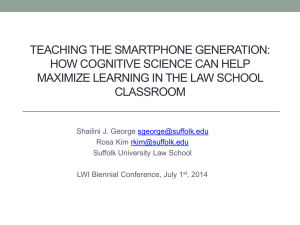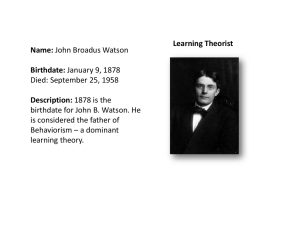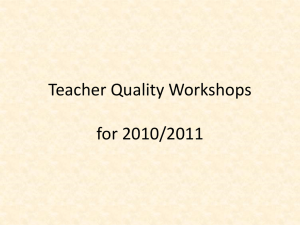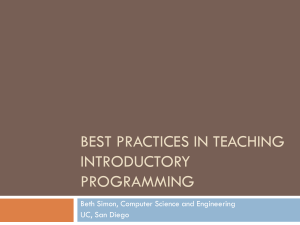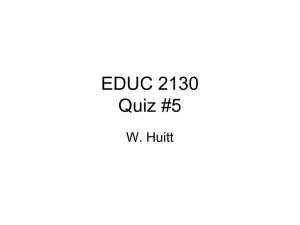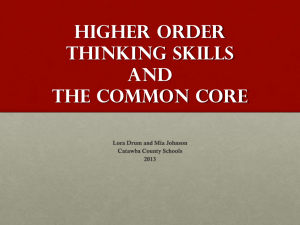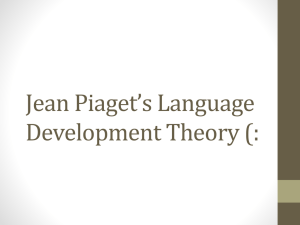Lecture notes
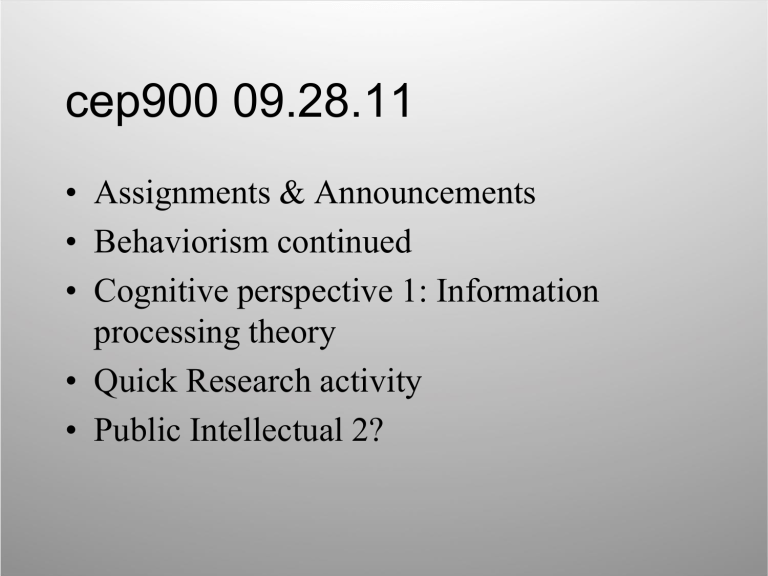
cep900 09.28.11
• Assignments & Announcements
• Behaviorism continued
• Cognitive perspective 1: Information processing theory
• Quick Research activity
• Public Intellectual 2?
assignments
RDP
meet w/ advisor about RDP
– annotate, only from HQ journals and handbooks
– learn from past RDPs
– prepare for meeting w/ me in Week 6
Readings
– Woolfolk, A. (2007). Social cognitive and constructivist views of learning (Chapter 9).
– Woolfolk, A. (2007). Complex cognitive processes (Chapter 8).
behaviorism - conclusion and continuing
watson’s bold claim
Give me a dozen healthy infants, well-formed, and my own specified world to bring them up in and I'll guarantee to take any one at random and train him to become any type of specialist I might select – doctor, lawyer, artist, merchant-chief and, yes, even beggar-man and thief, regardless of his talents, penchants, tendencies, abilities, vocations, and race of his ancestors. I am going beyond my facts and I admit it, but so have the advocates of the contrary and they have been doing it for many thousands of years. (Watson, 1930)
skinner’s critique of cognitivism
• “Having moved the environment inside the head in the form of conscious experience and behavior in the form of intention, will, and choice, and having stored the effects of contingencies of reinforcement as knowledge and rules, cognitive psychologists put them all together to compose an internal simulacrum of the organism…a doppelganger…the homunculus.” (Skinner, WIANACP, p109)
skinner’s critique of cognitivism
• “Behaviors change because contingencies change, not because a mental entity…develops.” (Skinner, p100,
WIANACP)
• Example? A child becomes more mature
– How does a cognitivist define “mature”? Perhaps, “knows” right from wrong and understands responsibility.
– How did this happen? An “internal” change?
– Or a change in contingencies in the environment (different behaviors-consequence relations)?
• Child – doesn’t clean room – no unpleasant consequence
• Adult – doesn’t clean room – unpleasant consequence
• What changed? Person or environment?
skinner’s critique of cognitivism
• “I am equally concerned with practical consequences. The appeal to cognitive states and processes is a diversion which could well be responsible for much of our failure to solve our problems. We need to change our behavior and we can do so only by changing our physical and social environments. We choose the wrong path at the start when we suppose that our goal is to change the “minds and hearts of men and women” rather than the world in which they live.” (Skinner)
chomsky’s critique of skinner
Chomsky’s famous critique and debate with Skinner
• Noam Chomsky (linguist), asked how can we understand and create sentences that we’ve never encountered before?
And, how can language develop so rapidly?
• Chomsky concluded it can only be that we have an innate capacity to understand the deep structure, the grammar, of language. We are born with a “language acquisition device” (L.A.D.)
• In other words, learning is not entirely constituted from experience – a central tenet of strict behaviorists.
b. f. skinner (1904-1990)
Shaping behavior: using carefully directed, contingent rewards can create almost any behavior. Start simple, increase complexity
Schedules for reward: rewards not only create behavior, but also maintain it.
Implications of behaviorism for education and society (e.g.
Walden Two) http://www.bfskinner.org/
a few big ideas in behaviorism
• Learning is the acquisition of new behavior, not new knowledge
• Behavior is shaped by the environment. The concept of free will is unnecessary or inaccurate.
• Teaching is engineering an environment. Any behavior, simple or complex, can be shaped with appropriate reinforcement.
• Learning in schools is characterized by too much punishment or negative reinforcement and not enough reinforcement. Also, reinforcement is not continent to the behavior it was meant to reinforce.
what happened to behaviorism?
Evolution
Neo-behaviorial approaches
Cognitive-behavioral
Social-behavioral
Chomsky’s critique
your intellectual lineage…
B. F. Skinner
N. L. Gage
E. D. Wong
You
(Others in your family tree include James Greeno, Lee
Shulman, Robert Calfee, Denis Phillips)
social learning & social cognitive theory
Social learning (N. Miller, J. Dollard)
• Highlighted the important phenomenon of learning from the experiences of others
• Vicarious reinforcement. No action needed, no consequence necessary.
"No-trial learning”
• Researchers interested in the qualities of influential models
Social cognitive (A. Bandura)
• emphasized identifying, expectancies, and efficacy - cognitive ideas
• Bobo doll experiment (Bandura)
• http://www.youtube.com/watch?v=hHHdovKHDNU
behaviorist and cognitive perspectives
A Comparison
• What is the nature of “knowing”?
• What is the process of learning?
• What motivates learning?
• What is the role of the teacher and student?
from a cognitive perspective
Learning is….
• a change in knowledge. Changes in knowledge can produce changes in behavior.
• a process characterized by goals, decisions, knowledge, strategies, reflection
from a cognitive perspective
Knowing is…
• “having structures of information that recognize and construct patterns of symbols in order to understand concepts..”
• exhibiting “general abilities such as reasoning, solving problems, and understanding language.” Greeno et al.
(1996), p. 18
cognitive constructs
Cognitive psychology makes use of many constructs
What is a construct? An explanatory variable (thing) that cannot be directly observed. constructs: understanding, motivation, intelligence, love, belief, personality, abilities, feelings, … not constructs: fish, wind, quantities, smell, behavior (directly observable)
cognitive constructs
Why have constructs? The purpose of constructs is to help explain something
Operationalizing constructs – defining constructs by specifying how they can be more easily observed or measured.
Discuss: How might you operationalize some cognitive constructs?
cognitive constructs
Cognitive constructs and what they reveal about the cognitive perspective
• Schema/structures for understanding
• Conceptual understanding
• Problem solving and reasoning
• General & specific strategies & intelligences
• Metacognitive processes
• Epistemological beliefs
• Beliefs about one’s learning and self
information processing basics
Information processing theory is on of the “early” kinds of cognitive theory
There are numerous kinds of cognitive theories, each characterizing knowing and thinking in different way. All cognitive perspectives acknowledge the importance of thinking and knowledge.
information processing basics
Central tenet: The mind is a complex system through which information flows
Central analogy: A computer
– information is encoded, recoded , and decoded
Central focus is on …
– thinking rather than behavior
– child as a cognitively active learner
context of ip theory
WW2, perceptual tasks, emergence of computer and communication technology
Intelligence = emphasis on efficiency (speed & accuracy)
Emphasis on information - rather than behavior, concepts, meaning
Built upon an architecture of symbols and logic, rules
ip architecture: components
Memory: sensory, short-term, working, long-term; capacity, speed
Processing: encoding, decoding, manipulation
Control processes: strategies, metacognition, metamemory
Knowledge: schemas, scripts, rules
Research focused on the role of components and how they can function more efficiently
General Model of Information Processing
Store Model (Atkinson & Shiffrin, 1968)
OUTPUT
INPUT
The “Software”
Response
Generator
Sensory
Register
Sights and sounds from the environment
Short-Term
Memory
Information that is currently active
Mental Strategies
Attention
Problem-solving strategies
Long-
Term
Memory
Permanent knowledge base
the nature of intelligence
Efficient and accurate processing
Constrained by "hardware", but strongly influenced by strategy use and knowledge.
Suggested that intelligence is learned (malleable) as well as inherited (fixed)
ip research: eye movement
•
Eyetracking Lab
IP research: problem solving strategies
ip research: memory capacity
Miller’s “7 plus or minus 2”
“Chunking” information and memory
ip research: memory
Activity
Read from top to bottom for each column. Repeat.
Look away and write words in any order.
ip research: memory
ball chair hammer cup typewriter book bird cord comb tree ghost meat
ip research: memory
Activity
Read from top to bottom for each column. Repeat.
Look away and write words in any order.
ip research: memory
couch table lamp rug pear pineapple orange banana dog rat horse sheep
ip research: memory
Activity: Read once, look away, wait 15 seconds, then write in order
3428670159
ip research: memory
3428670159
ip research: memory
216 774 4855
ip research: memory
Look at this board for awhile. Later, recall pieces and their positions.
ip research: spatial tasks
How long does it take to recognize these figures as identical or different?
ip research: development
What develops with age?
Does speed of processing increase with age?
38 47 75 33 22 35
86 64 25 34 12 19
87 22 16 11 36 22
88 79 98 35 13 39
72 27 46 31 64 82
73 13 45 52 91 37
Find "27"
IP research: Reading comprehension
The procedure is actually quite simple. First you arrange items into different groups. Of course one pile may be sufficient depending on how much there is to do. If you have to go somewhere else due to lack of facilities that is the next step; otherwise, you are pretty well set. It is important not to overdo things.
That is, it is better to do too few things at once then too many. In the short run this may not seem important but complications can easily arise. A mistake can be expensive as well. At first, the whole procedure will seem complicated.
Soon, however, it will become just another facet of life. It is difficult to foresee any end to the necessity for this task in the immediate future, but then, one can never tell. After the procedure is completed one arranges the materials into different groups again. Then they can be put into their appropriate places.
Eventually they will be used once more and the whole cycle will then have to be repeated. However, that is a part of life (Bransford, 1979; p. 134-135; original study by Bransford & Johnson, 1972).
ip theory applied to reading
• Knowledge of text structure
• Role of prior knowledge in comprehension
• Memory and comprehension facilitated by organization
• Reading metacognition and strategies
metacognition and strategies
Metacognition
• awareness of one’s own cognitive processing
• knowing what to do to facilitate cognitive processing
Domain specific strategies
• actions that improve one’s performance in a particular domain of learning. Examples?
• Although some aspects of the IP system cannot be changed, strategies can.
• Teachers help students develop strategies
discussion
The computer metaphor for human learning has been criticized as inaccurate or limiting.
What would you say in support of this statement?
What would you say in disagreement?
This might be a topic for Public Intellectual 2!
info-processing research
Quick Research
In teams, collect data using one of the IP tasks described in class, in the readings, or one you’ve created. Collect data from at least 3 participants. Report results and what you learned.
Might be an opportunity for Public Intellectual 2!

